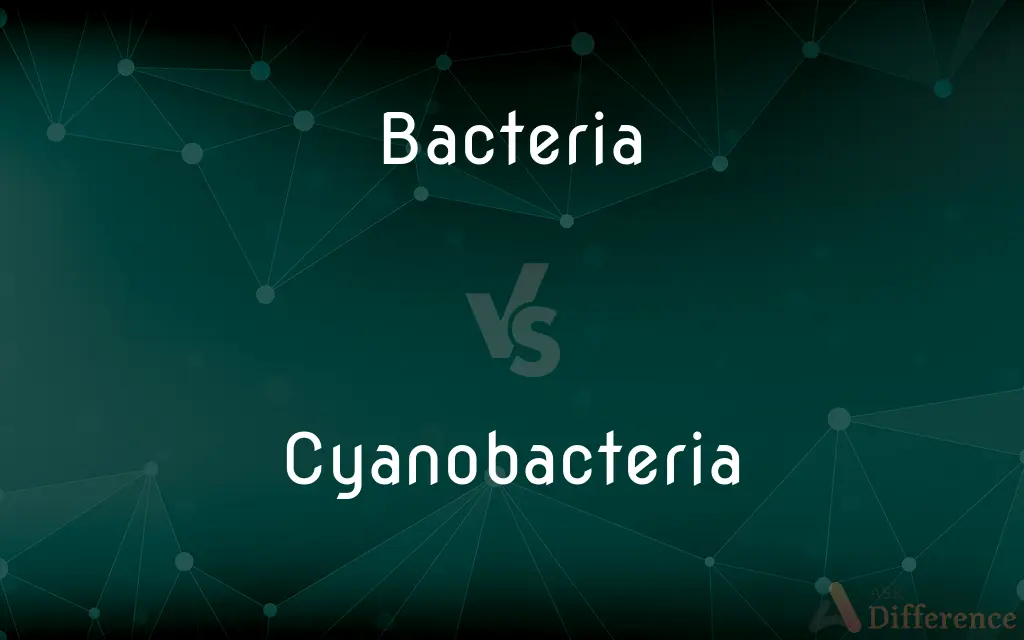Bacteria vs. Cyanobacteria — What's the Difference?
By Tayyaba Rehman — Updated on September 25, 2023
Bacteria are single-celled microorganisms; cyanobacteria are a specific type of photosynthetic bacteria that produce oxygen.

Difference Between Bacteria and Cyanobacteria
Table of Contents
ADVERTISEMENT
Key Differences
Bacteria and cyanobacteria, both microscopic in nature, play essential roles in our environment. Bacteria, encompassing a vast realm of prokaryotic microorganisms, are versatile and can be found in diverse habitats ranging from the human gut to the deepest trenches of the ocean. They can be harmful or beneficial, causing diseases or aiding in processes like fermentation.
Cyanobacteria, also known as blue-green algae, are a subset of bacteria that have the unique ability to perform photosynthesis. This group of bacteria played a pivotal role in the history of Earth, as they are believed to be responsible for the oxygenation of Earth's atmosphere billions of years ago, making the existence of aerobic life possible.
While bacteria, in general, obtain their nutrition through absorption, consumption, or photosynthesis, cyanobacteria primarily rely on photosynthesis. Using sunlight as their energy source, cyanobacteria convert carbon dioxide and water into glucose, releasing oxygen in the process.
Another distinction lies in the pigmentation. Cyanobacteria contain chlorophyll-a, which gives them a blue-green color. Bacteria, on the other hand, can have varied pigments, or none at all, making them appear colorless under a microscope. Despite these differences, it's crucial to understand that cyanobacteria are a type of bacteria, specifically distinguished by their photosynthetic capabilities.
Comparison Chart
Classification
Broad group of prokaryotic microorganisms.
Specific group within bacteria.
ADVERTISEMENT
Photosynthesis
Not all bacteria perform photosynthesis.
Photosynthetic by nature.
Pigmentation
Can be varied or colorless.
Contains chlorophyll-a, typically blue-green.
Role in Evolution
Diverse roles across many ecosystems.
Oxygenated Earth's atmosphere billions of years ago.
Habitat
Found almost everywhere (soil, water, organisms).
Common in freshwater and marine environments.
Compare with Definitions
Bacteria
Single-celled prokaryotic microorganisms.
Bacteria can be found on almost every surface on Earth.
Cyanobacteria
Photosynthetic bacteria known as blue-green algae.
Cyanobacteria blooms can turn freshwater green.
Bacteria
Can be either pathogenic (disease-causing) or beneficial.
Probiotic supplements contain beneficial bacteria for gut health.
Cyanobacteria
Responsible for oxygenating Earth's early atmosphere.
Cyanobacteria played a role in shaping the planet's aerobic environment.
Bacteria
Reproduce asexually by binary fission.
Under favorable conditions, bacteria can divide rapidly.
Cyanobacteria
Contain chlorophyll-a pigment.
The blue-green color of cyanobacteria comes from chlorophyll-a.
Bacteria
Lack membrane-bound organelles.
Bacteria do not have nuclei, unlike eukaryotic cells.
Cyanobacteria
Can form symbiotic relationships with plants.
Some plants have cyanobacteria living in their roots, aiding in nitrogen fixation.
Bacteria
Bacteria ( (listen); common noun bacteria, singular bacterium) are a type of biological cell. They constitute a large domain of prokaryotic microorganisms.
Cyanobacteria
May produce toxins harmful to aquatic life and humans.
Harmful algal blooms, often caused by cyanobacteria, can poison aquatic ecosystems.
Bacteria
Plural of bacterium.
Cyanobacteria
Cyanobacteria , also known as Cyanophyta, are a phylum of Gram-negative bacteria that obtain energy via photosynthesis. The name cyanobacteria comes from their color (Greek: κυανός, romanized: kyanós, lit. 'blue'), giving them their other name, "blue-green algae", though modern botanists restrict the term algae to eukaryotes and do not apply it to cyanobacteria, which are prokaryotes.
Bacteria
(US) A type, species, or strain of bacterium.
Cyanobacteria
Any of various photosynthetic bacteria of the phylum Cyanobacteria that are generally blue-green in color and are widespread in marine and freshwater environments, with some species capable of nitrogen fixation. Also called blue-green alga, blue-green bacterium.
Bacteria
Alternative form of bacterium.
Cyanobacteria
Plural of cyanobacterium.
Bacteria
Lowlife, slob (could be treated as plural or singular).
Cyanobacteria
Predominantly photosynthetic prokaryotic organisms containing a blue pigment in addition to chlorophyll; occur singly or in colonies in diverse habitats; important as phytoplankton
Bacteria
An oval bacterium, as distinguished from a spherical coccus or rod-shaped bacillus.
Bacteria
See Bacterium.
Bacteria
(microbiology) single-celled or noncellular spherical or spiral or rod-shaped organisms lacking chlorophyll that reproduce by fission; important as pathogens and for biochemical properties; taxonomy is difficult; often considered plants
Bacteria
Can have varied metabolic processes.
Some bacteria derive energy from sulfur in the absence of sunlight.
Common Curiosities
What makes cyanobacteria unique among bacteria?
Cyanobacteria perform photosynthesis and played a role in oxygenating Earth's atmosphere.
How do bacteria reproduce?
Most bacteria reproduce asexually through binary fission.
Are all bacteria harmful to humans?
No, many bacteria are beneficial, while some can cause diseases.
Do cyanobacteria belong to the algae family?
No, they are bacteria but are often called "blue-green algae" due to their appearance.
Do bacteria have a nucleus?
No, bacteria lack a nucleus and other membrane-bound organelles.
Can cyanobacteria be dangerous?
Some cyanobacteria produce toxins that can be harmful to aquatic life and humans.
Can cyanobacteria live in saltwater environments?
Yes, cyanobacteria can be found in both freshwater and marine environments.
Why are cyanobacteria important for plants?
Some cyanobacteria fix nitrogen, providing essential nutrients to plants.
What are probiotics?
Probiotics are beneficial bacteria that promote gut health.
Is it true that cyanobacteria changed Earth's atmosphere?
Yes, cyanobacteria are believed to have oxygenated Earth's early atmosphere.
Share Your Discovery

Previous Comparison
Crop vs. Capri
Next Comparison
Mood vs. AtmosphereAuthor Spotlight
Written by
Tayyaba RehmanTayyaba Rehman is a distinguished writer, currently serving as a primary contributor to askdifference.com. As a researcher in semantics and etymology, Tayyaba's passion for the complexity of languages and their distinctions has found a perfect home on the platform. Tayyaba delves into the intricacies of language, distinguishing between commonly confused words and phrases, thereby providing clarity for readers worldwide.














































